By Meredith Davis and Hugh Dubberly
Published in She Ji: The Journal of Design, Economics, and Innovation
Volume 9, Issue 2, Summer 2023
Abstract
This opening article for the special issue on the Future of Design Education traces paradigmatic shifts in design, from the twentieth-century mass production of artifacts to the twenty-first-century stewardship of evolving product-service ecologies. These shifts argue for a systems approach appropriate to the complex problems brought on by the industrial and information revolutions. Setting the stage for the following topical articles, the authors describe connections among human activities and technologies that are life-centered in their long-term impact on and by humankind. These changes are not simply in the things designers make but in the “why” of design practice under a paradigm that no longer focuses on the production of tangible goods. The article also addresses corresponding shifts in where designers now take action (for example, influencing organizational purpose, governance, infrastructure, and strategy, not just consumer-facing messages, objects, and spaces) and the lengthening of time horizons for evaluating design effects in natural, social, and technical systems. Ten principles for today’s designers offer guideposts for practice and inform a critique of the industrial-era traditions still present in much of contemporary design education.
How Knowledge Advances in a Field
In 1962, historian Thomas Kuhn published The Structure of Scientific Revolutions, a seminal treatise on how knowledge advances in a field. Kuhn’s account of disciplinary models that no longer address current conditions is a good fit with design today.
Kuhn defined normal science as established theories and facts that most members of a field agree address the most acute problems of the time. It is a consensus around a paradigm, around theories once sufficiently novel to have pulled advocates away from competing models but now seen as the basis of fact.1 Kuhn cautioned that a paradigm need not explain everything but that it suggests fundamental principles, rules, and standards that guide ongoing practice and research in the field.2 At the same time, said Kuhn, the paradigm has to be open-ended enough to encompass a range of problems or situations for practitioners to address.3
While there is usually debate and somewhat random exploration at the emergence of a new paradigm, discourse tends to subside as practitioners accept theories as the basis of fact. Kuhn argued that the model succeeds by continually revealing a family resemblance among the challenges to which it is applied.4 Using the paradigm as a filter, practitioners eventually regard some work as appropriate to the field and other work beyond its purview. Problems that fall outside the paradigmatic frame are seen as concerns of other disciplines or as too complex or ambiguous to have solutions. Kuhn classified the remaining work as puzzle-solving, which adds diversity to an inventory of successful applications under problems already assumed to have solutions.5
Anomalies illustrate the inadequacies of the established paradigm to account for some aspects of the problem type. Real discovery, said Kuhn, occurs when a few practitioners become aware of mounting cases that fail to meet the criteria of normal science and require new language, concepts, and procedures.6 In some instances, the field responds by relaxing the threshold criteria of the existing paradigm to make anomalous problems appear to fit normal science. However, a crisis occurs when anomalies demand increasing attention, blur disciplinary boundaries and rules, or erode the application of standards.7 In this sense, knowledge does not advance through a cumulative process of revisionary adjustments or simply by adding to the scope of an existing paradigm.8 Instead, a new paradigm is necessary to account for anomalous circumstances. Kuhn described this paradigm shift as a revolution.
Design Is in the Middle of a Paradigm Shift
There is no shortfall of evidence that design is in the midst of a paradigm shift and has been for some time (see Figure 1). The industrial economy that emerged in the early decades of the twentieth century reorganized labor and supply chains to meet the demands of mass production and consumer optimism for the future.9 A top-down management approach once viewed business as a system of inputs (knowledge, capital, materials. labor, and energy), transformational processes (design, manufacturing, and distribution), and outputs (goods and services) with the goal to optimize efficiency. Modern industry scaled production to address a scarcity of goods. Fueled by the developing marketing and advertising practices, stylistic changes encouraged continuous consumption through ensembles of visually and functionally related products and messages. Resources seemed infinite, and rapid technological development became synonymous with progress. However, the growth of the consumer society had consequences as people lost their connection to nature, imagined social status through the lens of manufactured goods, and traded place-based identities for participation in an industrial monoculture.
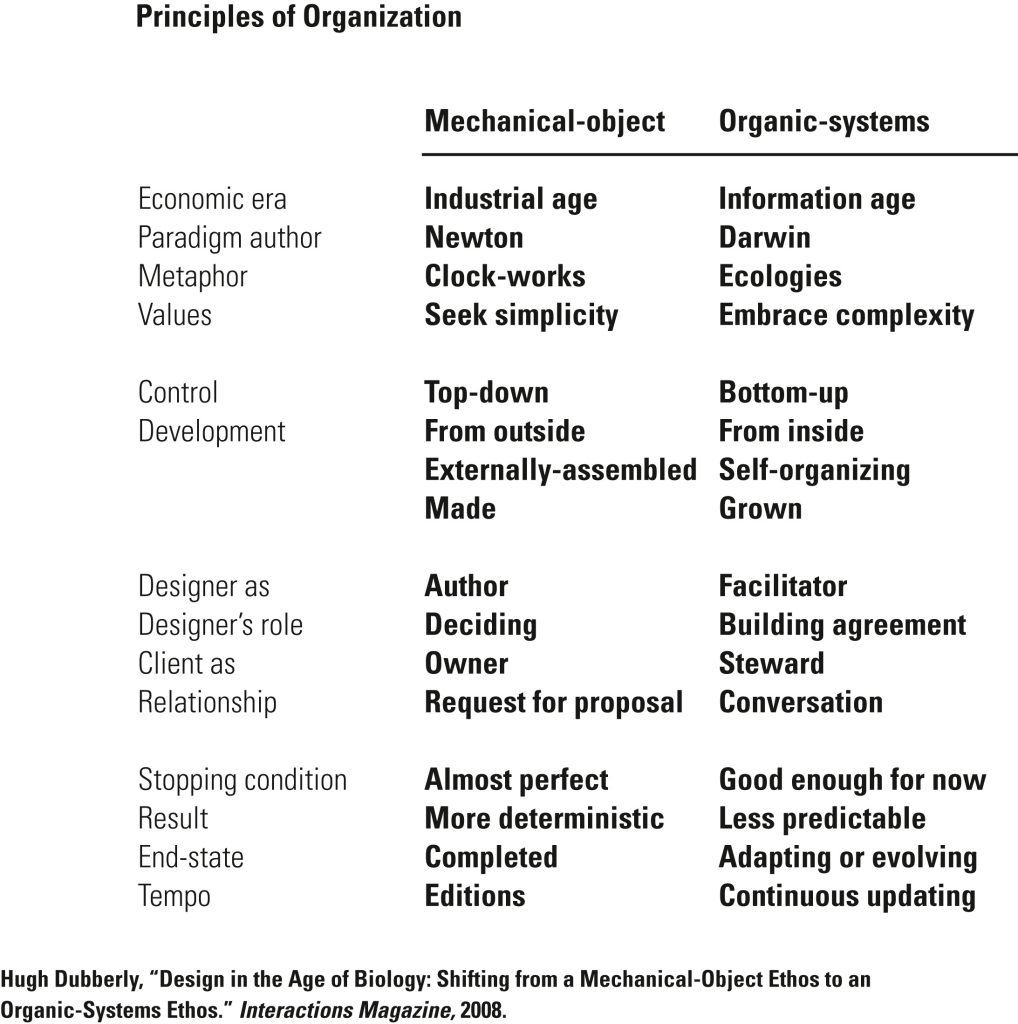
The experience economy of the late twentieth century emphasized lifestyle and brand, rooted in media narratives that spread rapidly through expanding digital technology. Under a Third Industrial Revolution—defined by advances in computing power and new ways of generating, processing, and sharing information—access to experience-driven systems and services became more important than the tangible attributes of the devices that delivered them. In other words, physical products became commodities with value and differentiation added by software. Technological acceleration divided the world into centers of innovation, places that serve centers of innovation, and places that struggle to keep up with a technologically connected world as a singular model of social and economic progress.10
A Fourth Industrial Revolution—an ongoing Information Revolution—now connects technologies and human activities in ways that blur the lines among physical, digital, and biological spheres. We understand life in terms of information encoding and decoding, flows, and feedback. The sheer speed and variety of current breakthroughs are without precedent and transform entire systems of production, management, and governance.11 This economy enables organizations and everyday people to create and distribute information, products, and services. Platforms extend the ability of others to build value networks through rules-based tools and systems that reduce investment in costly development expertise and time. Cross-functional teams create and modify these systems through bottom-up processes in which “good enough for now” (i.e., “minimum viable product”) is an iterative goal state. Ongoing user feedback improves each new version. Teams release early-and-often or even continuously in order to get diverse feedback as soon as possible, rather than waiting months or years to perfect editions. This bottom-up, iterative process largely replaces a waterfall sequence of management approval phases.
At the same time, a century of ignoring the external consequences of massively-scaled human activity illustrates that systems-level problems cannot be resolved simply by addressing a few leverage points in linear causal chains. Neither is there a singular, once-and-done solution for remedying damage to society and the natural world. Relationships among complex systems are volatile, difficult to predict, and require vigilance, as every design response can produce a myriad of effects.
As the context for design practice continues to change, so do the time horizons as the basis for action. We live in the Anthropocene, when human activity is the dominant influence on climate and the environment, raising unprecedented challenges. Design must be more than human-centered in its short-term benefits for individuals but also life-centered in its long-term impact on and by humankind. An article in Nature reported that human-made materials now outweigh all biomass on Earth.12 In 2016, the World Economic Forum positioned the challenges of this era as the most important the world has ever faced.13 The United Nations lists seventeen goals as a “blueprint to achieve a better and more sustainable future for all people and the world by 2030,” a universal call to action.14 Work today must change from thinking about short causal chains to acknowledging organic, often circular, and cascading effects in causal networks and over time. Moreover, design approaches must be holistic; sustainable and ethical practices must apply across all organizational activities.
Under this new paradigm, designers must better understand their roles as stewards and the scope of concerns that benefit society and the planet, not just the entities for which they work. College-level design programs must not only prepare students for an era very different from the artifact-centered practices of the twentieth century but also for long-term careers that will coincide with the expanding effects of the Information Revolution.
The Information Revolution
An information and service economy presented designers with situations that no longer matched the artifact-centered problems of the industrial era. It ushered in the rise of smart-connected product-service ecologies—systems of systems. Once characterized by user transactions, organizations and communities now seek ongoing relationships by offering greater access to the people and systems that run things. Companies convert products to services that are customizable, continuously updated, and extendable, eroding traditional internal and external control.
Computers are built into everything. Physical and virtual sensors monitor and gather oceans of information about people and the environment. Smart products, on-demand cloud computing, and pattern-finding software mediate people’s interactions with each other and their physical surroundings. Edge computing—a local or on-premises cloud—reduces cost, increases speed, ensures availability, and improves privacy and security. Artificial intelligence demonstrates the ability to produce generative solutions once thought to be the sole provenance of humans. Digital twins predict system failures and model trade-offs to lessen their impact. And platforms create opportunities for others to add functionality and create value.
The role of computing is ubiquitous. A world that records every action and every opinion also creates an explosion of data. The most valuable companies build and mine vast data collections. Worldwide, governments and non-profit organizations base decisions and advocacy on databases that reveal patterns in digital information. Analyzing data is increasingly important, and knowing the right questions to ask of all this information is a critical design skill. It is easy to imagine new roles for data science in a rapidly expanding design practice. However, an emphasis on measurement also has political and ethical ramifications; how data are collected, who has access, and the conclusions drawn are largely unresolved as technological capability outpaces best practices and policy.
An always-on-always-connected world also demands that designers know more about people and technology to maintain relevance, inform the next generation of products and services, and improve the quality of people’s experiences. Traditional design practices—mostly one-directional in their relationships between providers and consumers—are expected to lose jobs over the coming decade. On the other hand, employment projections show exponential growth in fields with active, dynamic engagement with people: interaction design, software design, service design, and strategic work with organizations and communities. For designers, computers remain a tool but are also a medium or channel through which the design outputs reach and learn from the people who use them. In an age of big data and artificial intelligence, designers must understand data structures, how machines “think,” and the social and ethical implications embedded in both. Moreover, in a knowledge-driven economy, the boundaries of responsibility are not always clear or fixed. Competitors may also be collaborators. Suppliers may also be customers. Employees may also be constituents whose wishes matter.15
The emergence of a knowledge-driven economy undermined the organization-as-machine metaphor of the industrial era. Organizations no longer measure success by their physical assets and assembly-line efficiency, but by the value created by all workers’ use of information and organizational responsiveness to change. Computers fueled early transformation by assisting management through mathematical modeling and tracking. As services overtake conventional products, there are demands for new forms of planning and management. This is an opportunity space for designers, but also for others. Fields interact and collaborate under a shift from sensing-and-responding to existing conditions to predicting-and-acting on new possibilities.
The Service Economy
The design of services not only differs significantly from the design of artifacts but also varies in scale and scope. In cases like a restaurant, services are co-constructed and confined to a physical place. In other examples, like post offices, services span space and time. Another model organizes products and services into ecologies that depend on networked hardware and data systems. The production of a physical object can be managed from beginning to end, typically through fixed plans, estimates, schedules, and budgets. Services, especially those delivered on the web, must adapt continually. Managers constantly monitor conditions, react quickly, and anticipate change.
Cross-functional, multi-disciplinary teams now develop products, services, and systems. The age of the solo designer is mostly over. Developing successful products and services rests on three pillars (see Figure 2). The first is to make something desirable for the people who use it (to make it useful and usable). Designers contribute to this goal through models of what ought to be. The second pillar sustains the organization that offers the product or service (makes it viable). Managers contribute to this goal through a business model, even when the organization’s purpose is not to grow profits. The third pillar ensures that the technologies required to build a product or service are available (makes it feasible). Engineers contribute through a technological model. Within these three pillars is increasing concern for what is equitable and sustainable. That includes attention to the diversity and inclusiveness of constituents’ views of what ought to be and the policies, practices, and technologies that sustain both organizations and life on the planet.
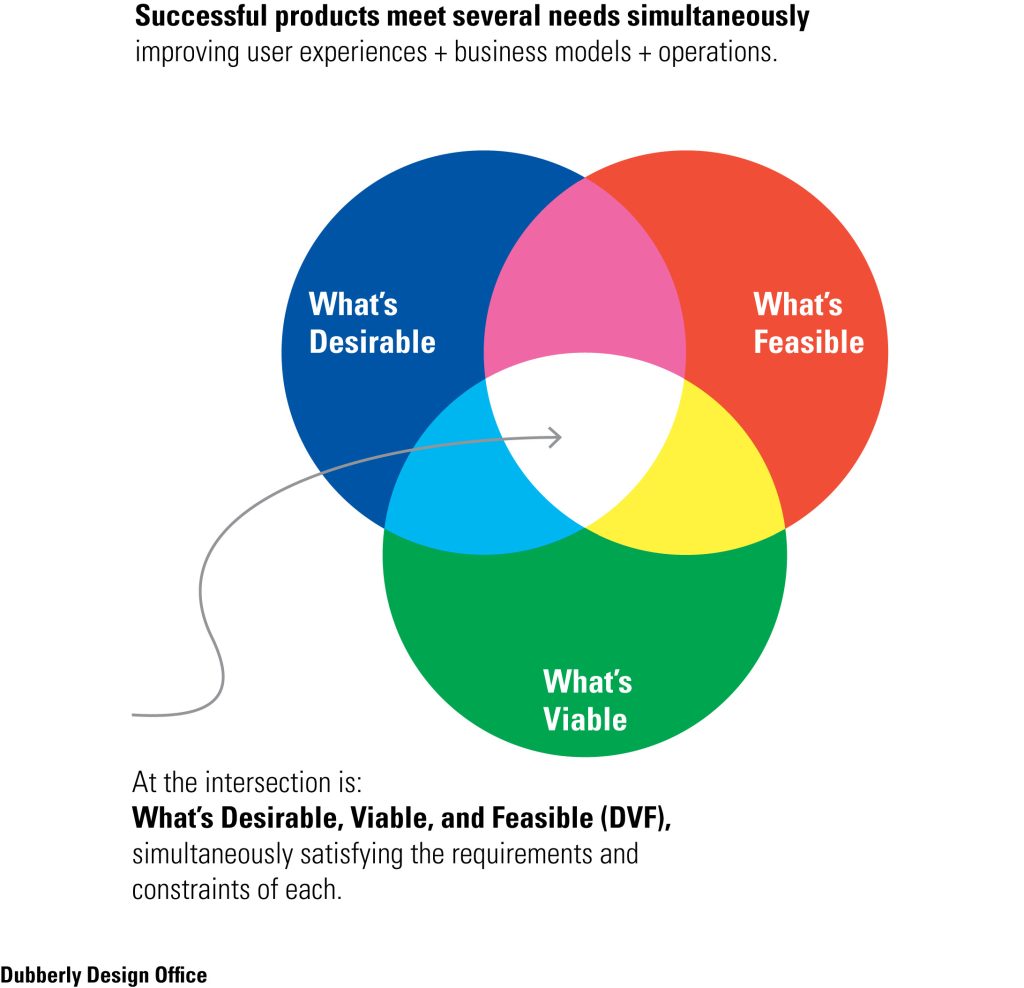
Since these models interact, their development must be simultaneous and collaborative. Representational strategies—modeling, simulating, and prototyping—facilitate choices by stakeholders of what to bring forward. These choices often involve trade-offs, underscoring the political nature of design.
Product managers, who are responsible for bringing new products, services, or platforms to market and for maintaining and improving them, often lead the teams that address these issues. This crucial role involves coordination across many fields—senior management, research, engineering, quality assurance, marketing, design, and more. It requires looking outward (at customers, markets, technological trends, suppliers, and competitors) and inward (at capabilities, teams, schedules, costs, features and benefits, pricing, and more).
A great deal of what product managers do parallels what designers do. Both are concerned with innovation. However, design education rarely addresses product management, much less prepares designers for this role. The designer’s process usually stops at the presentation of a prototype and starts over again from scratch with a new project. At the same time, few business schools offer serious product management study because the content falls outside traditional business interests in finance and marketing. As unclaimed curricular space, product management offers design students new employment opportunities and a ladder to upper management.
The Socio-environmental Challenge
Technology measures everything and uses much of the data it collects to tell us about ourselves and the systems we engage; we think about our bodies, minds, and social interactions in entirely new ways. Fitness devices monitor our health by the second. Drones and imaging technologies extend our physical reach, allowing us to see what was previously inaccessible. Artificial intelligence learns from us as the boundaries between biology and technology become increasingly porous. Social networks collect and re-purpose personal details from digital interactions, reminding us that faces, places, and traces have an afterlife. Many of these systems change the relationships between the providers and consumers of information. Ordinary people become content producers, manufacturers, and critics. They influence what gets made and what it means in everyday life.
Technology also reveals more about nature and human effects on the environment than can be observed through everyday experiences. It records and models the pace and consequences of unfolding processes that span generations and projects future states. However, much of the story told by this information is not good. Centuries of social policy and industrial activity—including the products of the information age—degraded natural systems so that regeneration, not just restoration, is an existential priority for the planet. There is a need to reconsider the long-standing political and economic agendas that keep humans and nature in harmony, especially in developed countries. Designers will find insights from indigenous cultures that live close to nature, biology and the responses of other species to their surroundings, and the self-regulatory and regenerative behavior of healthy systems. Progress will require broad social commitment, built through practical and verifiable demonstrations that a life-centered design approach can make a difference.
Therefore, designers confront a complicated and ever-expanding network of interdependencies. Their job is no longer a simple “form follows function” equation (if it ever was) but the mediation of dynamic relationships between people and natural, social, and technical systems. Data also verify that the distribution of social and environmental consequences resulting from human behavior is uneven and political; that some groups and places are disproportionately affected as these systems struggle to maintain equilibrium under increasing stress.
The result is a class of problems that design theorist Horst Rittel called “wicked.” He described them as a paradox. On the one hand, they are grounded by a belief in infinite “makeability” under “reasoning and civilized negotiation.”16 On the other hand, they call for “compassionate engagement and dramatic action”—a “feeling approach”—to overcome the unequal effects in the distribution of social capital.17 These situations share characteristics not present in the formal crafting of messages, objects, and spaces. There is no definitive explanation of any wicked problem, which leaves some uncertainty regarding where disciplinary responsibilities might begin and end. Necessary information emerges in trying to change the situation, including viewing things through various lenses. It is through ongoing argument, rather than a priori checklists of performance criteria or traditional job descriptions from the industrial era, through which relevant conditions become clearer.18 Wicked problems also lack a stopping rule; there is no test for determining that the problem is solved.19 And every wicked problem is a symptom of another problem. There is a discrepancy between the existing state of affairs and what ought to be. This discrepancy can be described in many ways and at many different scales.20 For these reasons, it may be better for design education to talk about situations and responses than problems and solutions.21 The nature of this work is why framing today’s dynamic socio-environmental challenges may be more important in allocating student time than executing “almost perfect” solutions.
The shift in complexity that today’s socio-environmental challenges represent also changes the material with which designers work. For example, a software application maps the viewshed (what can be seen from various locations and at different elevations) of a mountainous region.22 Overlaying that map with plots of privately-owned property and a second map of buildable or cultivatable terrain reveals locations that cannot be developed but are critical to the experience of the natural environment. By donating that land to the nature conservancy in perpetuity, property owners gain tax advantages from “unusable” land, the eco-tourist industry benefits from uninterrupted viewsheds, and a significant chunk of nature remains untouched. The “stuff” involved in this design challenge is not screens and interfaces. Although it is necessary to design these things, the focus is not an interaction design problem. Instead, good outcomes for nature and society depend on designers converting the material of economic infrastructure, government policy, and cultural reputation into stewardship. The software merely mediates those important relationships.
Working with these new materials at scale requires new methods. The unit of analysis is rarely an individual user, and the results of design action play out over time periods not easily addressed by traditional testing. Critical to these methods are representational strategies that communicate complex information in ways that various co-designers can understand. Furthermore, team members must have at least a conversational understanding of the language of other disciplines, including data science, which informs decision-making.
Relationships between Designers and Their Work
The Information Revolution changes the things designers make and the tools and processes through which they make them. It also changes the relationship between designers and their work; the why of design practice and what design means under a paradigm no longer focused on scaling the production of tangible goods (See Figure 3). Many student portfolios still reflect an industrial perspective. They represent an individual’s decisions regarding the function and appearance of discrete artifacts—even when digital and even when applied to social problems—rather than the expanding concerns of contemporary practice.
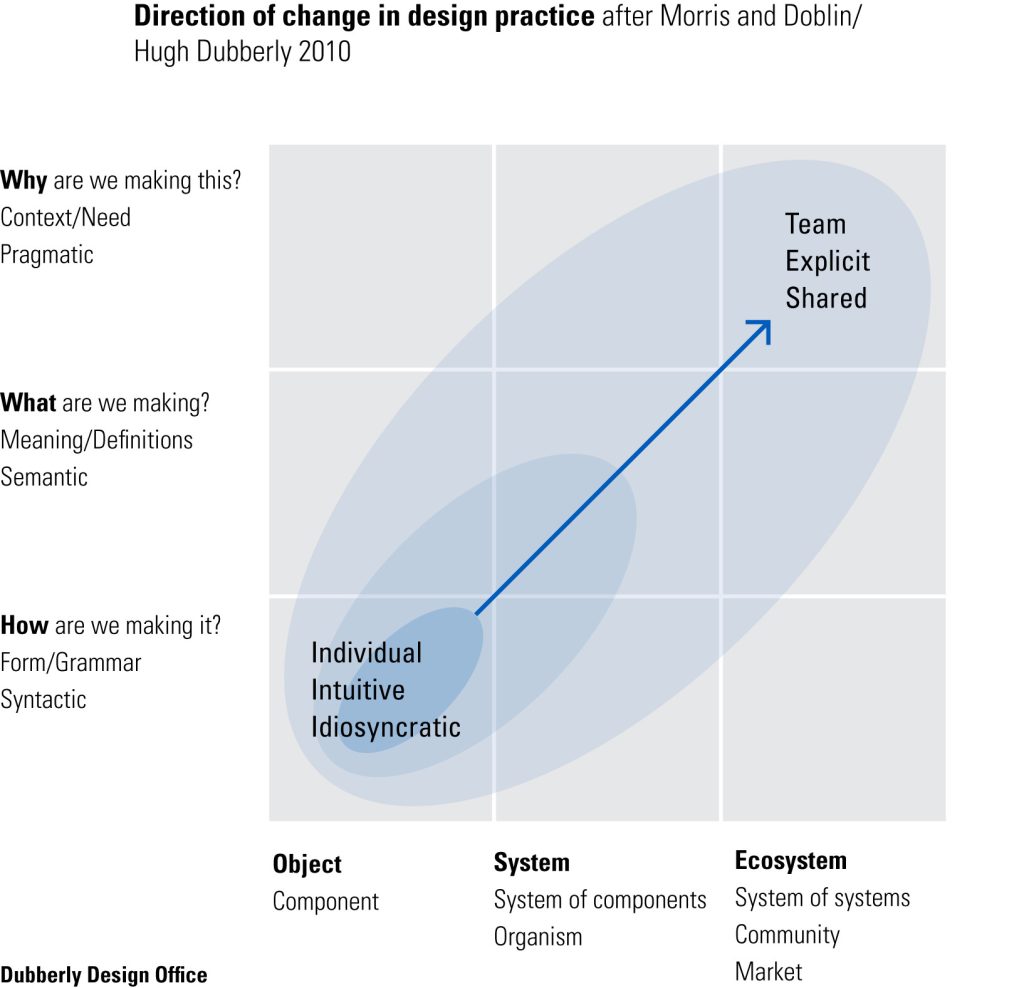
Stewart Brand, founder of the Whole Earth Catalog and author of The Clock of the Long Now, offered a model of how a healthy society works through functional layers that change at different rates (see Figure 4, Figure 5). Like natural ecosystems, various layers of society absorb and incorporate the stress of change at different scales. Brand summarized: “Fast proposes, slow disposes. Fast is discontinuous, slow is continuous…. Fast gets all our attention, slow has all the power.”23 He described the consumer-facing Fashion layer as “engaging…, free to experiment as creatively and irresponsibly as society can bear.” 24Commerce instructs but does not control the levels below it. It is “shortsighted … passing some of the velocity [of change] and wealth on to infrastructure.”25 These two fast-changing layers are the historical locus of design. As such, traditional design practices and education have focused primarily on instrumental know-how, usually with short-term performance goals. Attention to consumer-facing elements served eras in which designers sought optimization of the production process and user-centeredness.
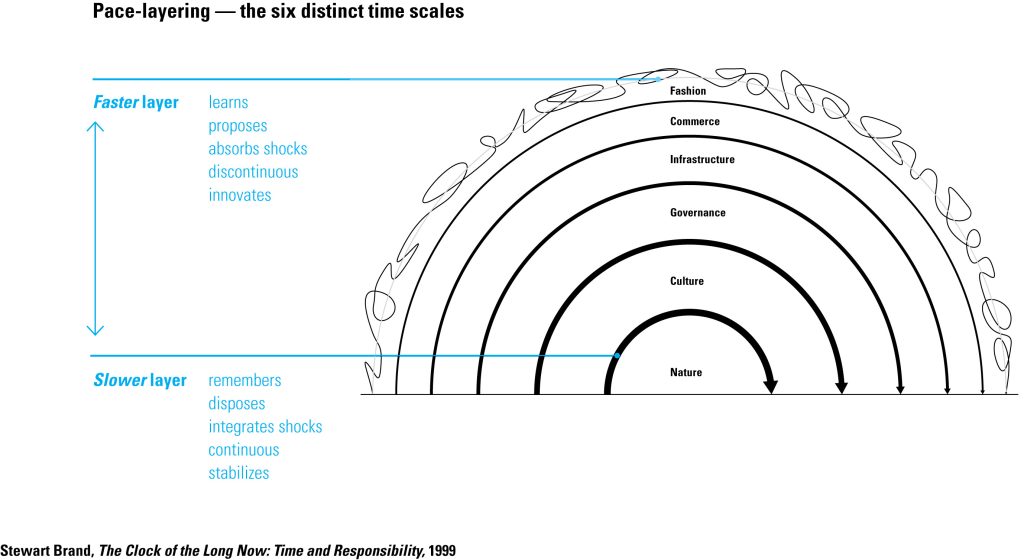
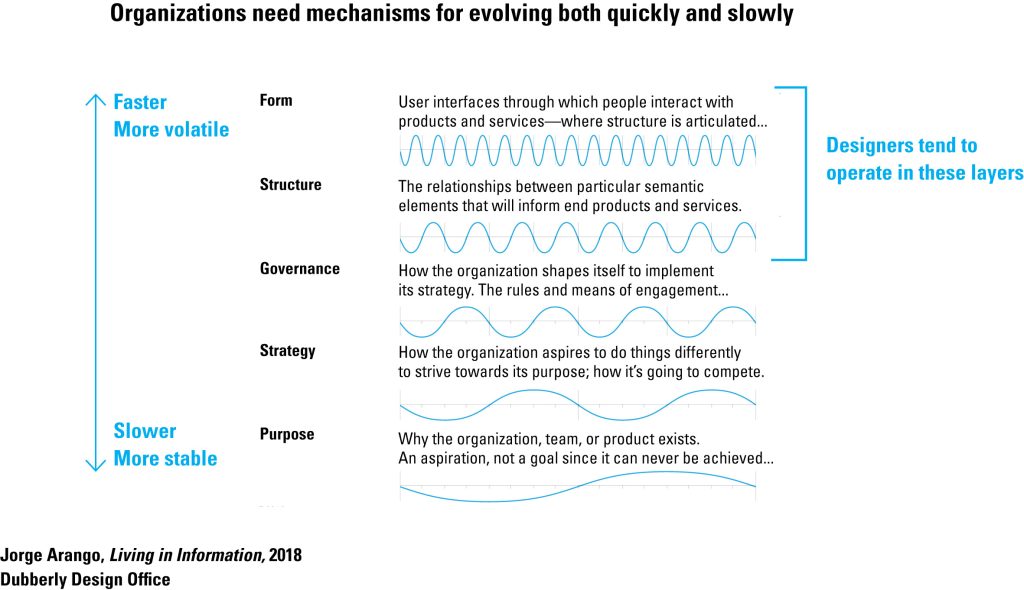
Today’s context for practice, however, extends designers’ concerns to more distant horizons and the slower-changing levels of infrastructure and governance where effects are more consequential and enduring.26 Such layered effects are both internal and external to organizations. Using recycled materials, for example, is simply greenwashing if not matched by a company’s purpose-driven commitment to energy-saving production and end-of-life product strategies. In this sense, the focus of design shifts from what and how to why, from things and processes to intentions, such as improving, facilitating, provoking, and conserving.
A Four-Field Framework
Conceptualization of a new paradigm and coherent articulation of theories and models that give it structure take time. The process often involves episodic departures from tradition or subdivision of the field to accommodate work that represents new perspectives and questions. As Kuhn warned, resistance is typical. Design professors Bruce and Stephanie Tharp offer a Four-Field Framework, which replaces a once-singular, industrial-era definition of practice with different but interacting professional agendas (see Figure 6, Figure 7).27
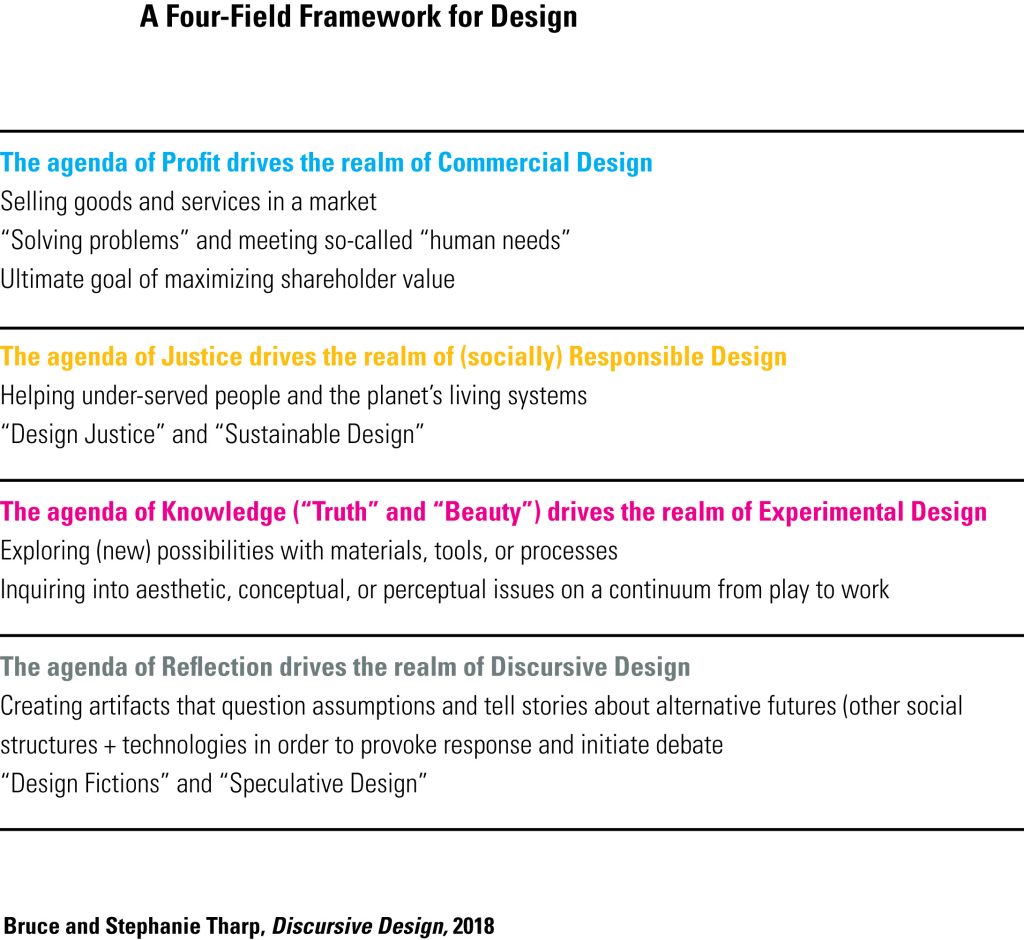
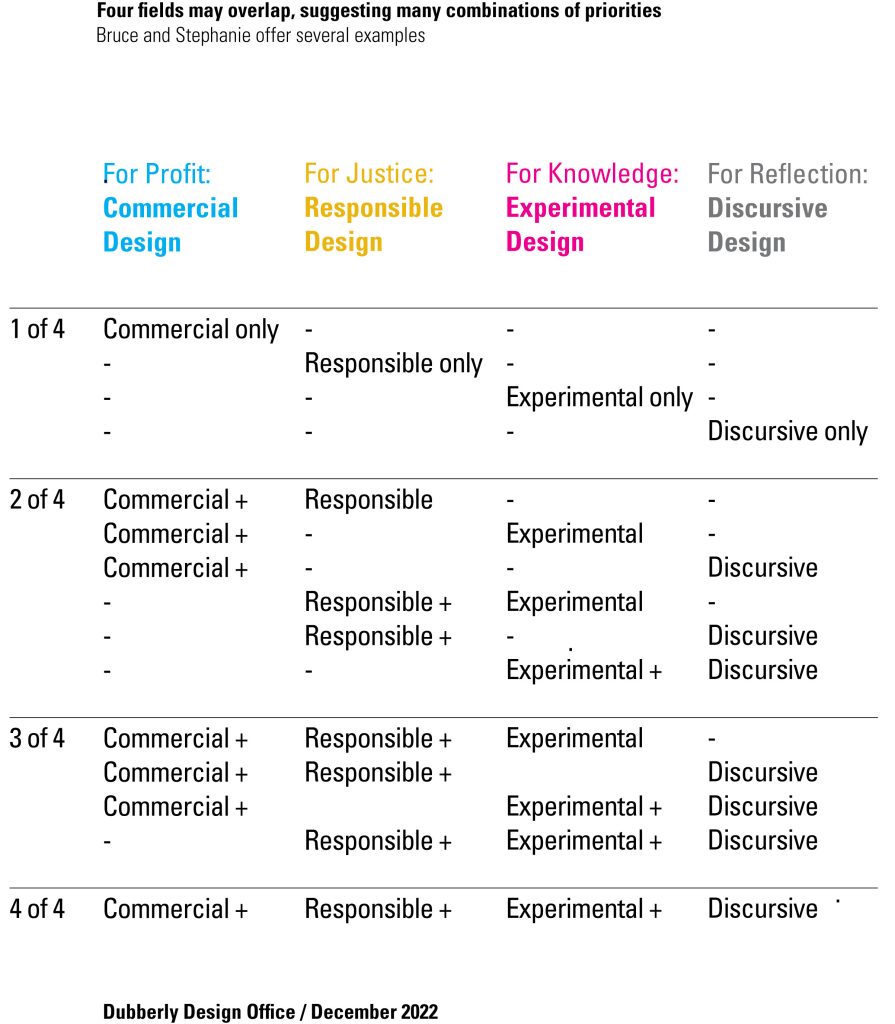
Although design education programs may foreground one of the four agendas as a lens on future professional obligations, all design curricula share some responsibility for graduate success across this diverse world of work. While the primary intent of Responsible Design is social and environmental justice, its emergence as a practice does not relieve Commercial Design from attention to social and environmental outcomes. Likewise, justice-driven careers are neither viable nor sustainable if schools ignore that design and production are embedded in a matrix of capitalism and politics.
Ten Principles for Today’s Designers
Despite the diversity of practice, there are overarching principles that should guide the work of all designers.
- Think in terms of systems: Contemporary design challenges reside at the level of living systems, not freestanding artifacts. The work of design is no longer to make changes at a few places in a simple cause-effect chain for entirely predictable results and to resolve problems of limited scope once and for all. Instead, forces and elements constitute complex networks where any action can ripple through the system. Even when responsible for only a small part of the system, designers need to understand the interdependent relationships within situations that produce particular patterns of behavior and effects. Change in any single element or relationship may affect the ability of larger systems to maintain functional stability. Systems are natural, social, and technical, each with subsystems that regulate their behavior. They respond under the influence of economic and political forces and require modeling that includes context, actors, goals, processes, and information flows, interpreted as unfolding stories of how elements interact.
- Pay attention to feedback: Viewing the relationship between cause and effect as one-directional misses the point that an effect can also be a cause. A systems perspective frames the space for possible design intervention regarding multi-directional interactions in which outputs are rerouted as inputs. Therefore, designers should think of their work in terms of dynamic situations rather than discrete problems to be solved. This principle applies to natural and social systems as well as technical systems. Designing with people rather than for people involves increasing and improving iterative models through ongoing feedback.
- Act at the appropriate scale: Designers must identify the levels and time horizons under which action is most likely to produce positive outcomes. In the short term, it may not always be possible to act on a situation at the highest level. Some lower-level activities should match available resources and stakeholders’ comfort. However, all work should consider cascading effects at other levels and contribute to long-term success. Always act to increase the number of future choices.28
- Consider consequences, intended and otherwise: Designers need to identify the forces of change and effects over time. They need to anticipate, not simply react. An intention to change human, organizational, and societal behavior must consider both the positive impacts and potential negative consequences of proposed work. Long-range planning should be life-centered and evaluate the benefits of action regarding people’s well-being, workers’ and shareholders’ prosperity, and environmental responsibility. A philosophy asserts that today’s decisions should result in a sustainable world seven generations into the future.29
- View information systems as the new material of design: Data, algorithms, digital twins, and other computational forms are delivered through networks of smart connected products and product-service ecologies. Information systems record and measure everything, including social behavior and environmental conditions, in ever-increasing detail. Many systems learn from use; the more people interact with the system, the greater the recognition of patterns that inform responses. Design now builds on existing networks and platforms as versions rather than completely new editions, suggesting that work today rarely begins from scratch and requires ongoing adjustment. As rules-based structures, these systems embed assumptions and values that call for continuous interrogation regarding their effects and ethics.
- Decenter humans to restore and sustain ecological balance: Designers must consider the interdependent relationships between human activity and environmental systems to redress negative impacts and contribute to a healthy biosphere. Data from sensors, satellites, and other technical systems monitor environmental well-being, suggesting trajectories and rates of change not easily observed in the short term. Overarching design responsibilities include ecological balance and remediation that reverses the twentieth-century human impact on the planet.
- Strive for inclusivity: Designers need to pursue a diverse and equitable community of practice and respect the voices of all affected by their actions. Their work needs to reflect that design always takes place within a context of power and should advocate and mediate for those with less privilege. Action includes overcoming barriers to equal access in the physical and information environment. Participatory design processes should address how a situation is framed and negotiated, plans and models for improving it, and processes and responsibilities for taking action. Meta-design processes should involve designers in creating situations in which others can design. Inclusive design also examines the values implicit in the rules that govern the behavior of and access to systems.
- Respect the importance of community, place, and culture: Historically, the industrial era promoted a design monoculture. Design communities worldwide trained in and followed philosophies established in Europe during the first half of the twentieth century. These traditional philosophies were grounded by a principle of universal human experience and a singular notion of progress. Currently, there is a growing demand for designers to build upon existing place-based cultures and value structures, including those of indigenous peoples, citizens in economically developing regions of the world, and sub-groups that experience systemic discrimination or marginalization. Communities are defined by more than demographics or shared geography. Their members have a sense of where they came from, negotiate where they are going, and have structures for making decisions and managing relationships. The intersections of individual, social, and cultural experiences shape values and behavior and, thus, encourage designers to use a range of methods from the social sciences to understand people and their contexts.
- Support decisions with evidence: Designers can no longer rely on creative intuition to address complex situations. They must adopt methods and procedures of evidence-based practice in work of local and global significance. They must become familiar with new data systems that monitor the state of things and inform decisions. Designers must also build in data collection and analysis from the beginning of projects, evaluating outcomes across the product, service, or system lifespan. Likewise, they must know when the design challenge requires engaging other experts in the research effort.
- Accept accountability and behave ethically: Although current design practice emphasizes economic accountability, individual designers, professional associations, and policymakers must also address necessary legal and ethical standards. Criteria must focus on making the world better, more just, and more sustainable. Designers must account for the full range of consequences that their work produces across interdependent systems. They must respect individuals’ beliefs, safety, and privacy. They must weigh their choices of materials, tools, methods, and technologies and do no harm. They must act mindfully, treat people politely, respect people’s dignity, and foster choice and social cohesion. Such considerations are not afterthoughts in a design process—not just what designers do, but who they are.
Implications for Undergraduate Design Education
Resistance to a new paradigm is typical. A field is less likely to reinvent itself when practitioners maintain an identity associated with a long-standing view of the field, as they do in design. Textbooks, lectures, and curricular strategies through which students learn about practice codify established theories. However, they appear after, not before, a paradigm shift, creating the illusion of continuous adaptation to changing conditions.30 Professional education transmits tacit rules through examples of “good work” and engages students in learning by doing under favored frameworks and known problems. The old paradigm persists until mounting anomalies demonstrate its inadequacy in solving new problems or confronting new conditions. Design education is in just such a state, inheriting industrial-era curricula that fall short in addressing the contemporary context for professional practice.
As a discipline, modern design practices entered the undergraduate art departments of freestanding vocational schools and universities during the first half of the twentieth century. The Bauhaus, in particular, offered a curricular model easily replicated by existing fine arts faculty as they responded to increasing institutional pressure to address practical post-war problems and industrial opportunities. The model spread worldwide through faculty immigration to other countries and curricular experiments in high-profile institutions. Based on form and the mastery of modern materials, the curriculum devoted little time to studying people, contexts, and theories beyond those of perceptual phenomena. Advocates justified the approach as meeting unmet demand for manufactured goods. However, very few Bauhaus products were produced in their own time, and affiliations with industry declined across the school’s history. Design critic Tony Fry described Bauhaus design as mostly “published representations” of industrial work rather than mass-produced products with public appeal.31
The signature pedagogy of design that developed during this mid-century era produced several important outcomes that remain relevant to today’s design practices (see Figure 8). College-level studios focus directly on applied work under project-based learning experiences. Through this pedagogy, students master making processes and build confidence in taking tangible action on goal-driven ideas. Because work can always improve, they commit to long hours and ongoing conversations in close-knit communities of faculty and peers. Design students typically perform better in presentations than students in other fields, primarily due to the story-telling nature of the design process and frequent critiques.
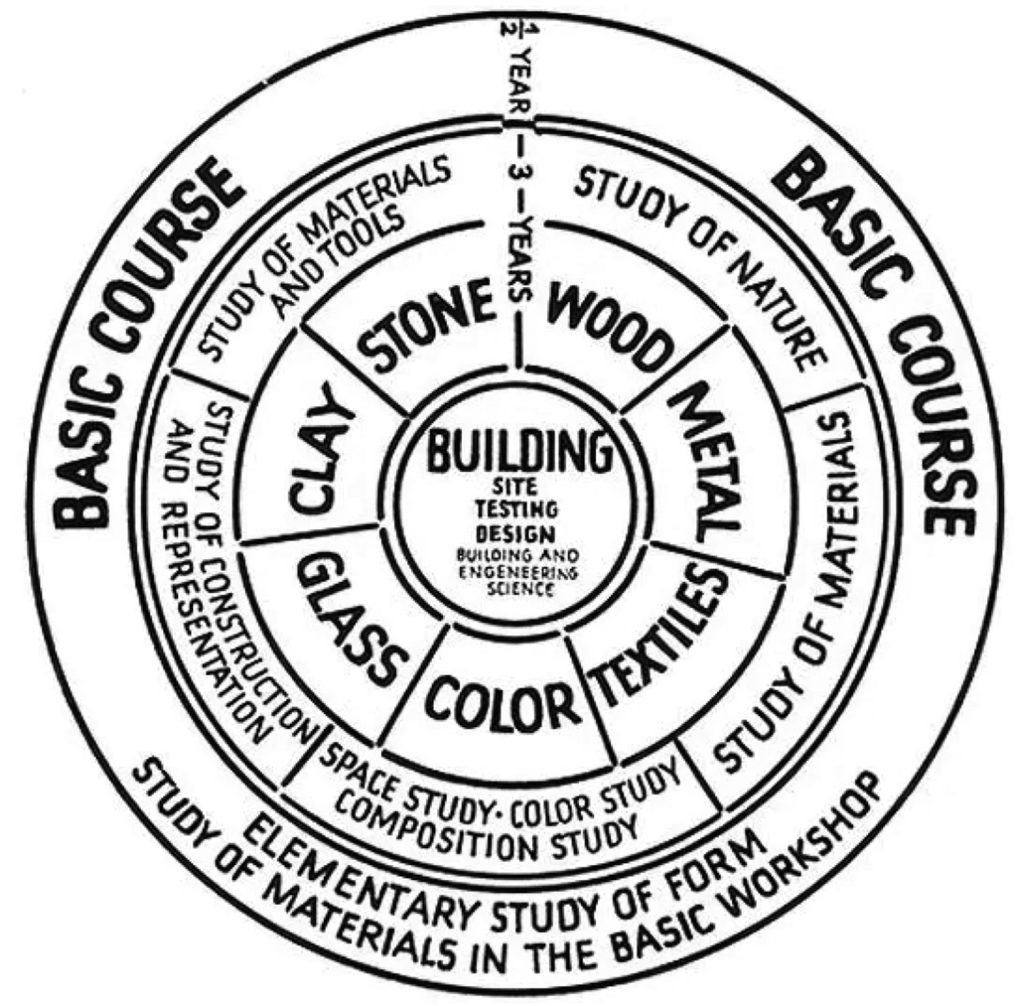
At the same time, the historical location of design programs in art schools and departments firmly grounds the curricular emphasis on appearance and craft. Most foundation programs still devote at least one full year to perceptual studies, material mastery, and a design process that begins most assignments with sketching. The implication is that it is possible to find the response to every problem or situation in form and that principles applied in diverse contexts will produce the same results as principles studied in isolation. Foundation courses prepare students for artifact- and medium-defined investigations at the upper levels of the curriculum. Artificially limited by the affordances of a medium, these courses are examples of the puzzle-solving work that Kuhn describes as adding to the diversity of applications under an established paradigm.
The applied problem-solving purported to distinguish design from fine art is also a residue of the industrial era. Faculty typically frame problems to foreground a principle, often for which there are well-known applied examples. All students in the class compare solutions to the same problem—mirroring industrial-era optimization—rather than explore the implications of framing situations differently. Under disproportionate time spent on form and execution, students aim for “almost perfect” results that resolve friction in a singular problem. Faculty randomly determine such problems across the curriculum with little explicit patterning to elucidate models of recurring situations. Design guidelines, system rules, and policy proposals rarely qualify as outcomes of studio work, even when the purpose is to resolve complex social or community issues that depend more on engagement, infrastructure, or governance than artifacts. The student’s task is to master a repeatable process for identifying the cause of dysfunction under the assumption that the right change will forever resolve difficulties. Complexity under this perspective is defined primarily by the number of elements or things to be designed, not by the variety, volatility, or velocity of change in the relationships among them.
Despite clear trends favoring employment in developing technological systems that support products, services, and civic engagement, most design programs teach little more than software application skills. Few students learn to code, build on platforms, or acquire skills in setting up, monitoring, and managing design systems. Projects are typically one-off experiences, rather than development of successively-built generations to which multiple students contribute. Although a few schools offer analytics studies, design students are generally unfamiliar with data-collecting technology, measurement, and machine learning prediction. Most complete their undergraduate studies without an introduction to statistics that explain drivers of future collaboration in business, social policy, and environmental science. Even as heavy cloud users, students have little understanding of how data is configured and travels the network. In not knowing, they lack the ability to uncover and argue against unethical practices, imagine what is possible, and make meaningful contributions to planning.
While there is a frequent argument that designers need to move higher in organizational management to address situations of more significant consequence, there is little explanation of curricular experiences that make such advancement likely. The consumer-facing artifact orientation of most design programs is ill-suited to work related to organizational purpose, governance, infrastructure, and strategy. Likewise, design programs struggle with the development process for systems, services, platforms, and communities as different from one for messages, objects, and spaces alone. Many design programs interested in influencing management rely on a potpourri of existing courses in business schools rather than studies targeted to the transformative and product management roles design can play in organizations. The lack of management content is of particular concern in programs that promise social innovation careers, which depend on the fulsome understanding of the policies, procedures, and cross-sector relationships through which large-scale social, political, and economic systems work.
Graduate Education and Preparation of the Professoriate
Post-graduate programs in design emerged at the tail end of the industrial era in the second half of the twentieth century. The revenue generated by advanced programs is critical to many freestanding art and design colleges. In multi-purpose institutions, advanced offerings frequently lend status to programs. These conditions incentivize the proliferation of master’s and doctoral programs, often in the absence of student demand and under confusion by the field about the roles they play in practice.
Master’s degree curricula show little consensus regarding the intent and content of study. Purposes include the development of a personal design philosophy, refinement of formal skills, specialization in an area of practice, and qualifications for future doctoral study or teaching careers. For some students, the master’s degree is a first professional degree with entry-level practice as a goal.
Few master’s degree students bring deep professional experience to their graduate studies, encouraging them as future faculty to mirror their own education rather than the current context for practice. At the same time, programs rarely involve students in coursework related to teaching. Lacking curricular experiences in framing research questions, choosing and implementing methods, and meeting rigorous standards, many master’s degree graduates also enter faculty positions unprepared for the research expectations of universities. They rely, instead, on small freelance projects, essay writing, or arts activities to satisfy the scholarly demands of their departments. Ultimately, undergraduate education cannot change without first rethinking the programs that produce their teachers.
Changes in government attitudes regarding national research output and students’ ability to study across national boundaries added previously vocational schools to the list of doctoral-granting institutions in a number of countries.32 Uneven in the intellectual resources necessary for rigorous doctoral study, this mixture of institutions fosters indeterminate research standards that straddle both fine art and design. Further, programs conflate reflections on one’s own making activities with evidence-based research investigations under the same degree title, PhD in Design. While the general mission of a PhD is knowledge- and theory-building, the field also needs research in emerging practices that is the more typical work of professional doctorates in other fields. Therefore, a shifting paradigm in design practice—one of increasing accountability for anticipating the consequences of design action—calls for a clear, non-hierarchical distinction among doctoral degrees.
Conclusion
The observation and conceptualization of new phenomena take time, as does the coherent articulation of new theories and the models that give them structure. As environmental and social problems deepen and the Information Revolution and parallels in the bio-sciences accelerate, design practice will continue to evolve with greater urgency for defining its role. Designers must continue to learn, even after they leave school, to adjust to a new paradigm. Design education has an opportunity to create more value to society, to connect novices with experts, link professionals, and make schools centers for lifelong learning.
To accomplish such outcomes, college and university programs need to interrogate the normal science of design and rethink the paradigm that underpins their curricula and pedagogy. They need to offer concrete proposals for competing theories that counter inadequacies in response to an emerging future. The articles that follow in this Special Issue represent a few ways of thinking about that task.
References
Arango, Jorge. Living in Information: Responsible Design for Digital Places.
New York: Two Wave Books, 2018.
Brand, Reon. “Co-emerging Futures: A Model for Reflecting on Streams of Future Change.” Paper, published by Philips Design, 2019. Available at: https://www.researchgate.net/publication/333972702.
Brand, Stewart. “Pace Layering: How Complex Systems Learn and Keep Learning.” Journal of Design and Science (January 17, 2018: online. https://jods.mitpress.mit.edu/pub/issue3-brand/release/2.
Hugh, Dubberly. “Design in the Age of Biology: Shifting from a Mechanical-Object Ethos to an Organic-Systems Ethos” Interactions 15, no. 5 (2008): 35-41. https://www.dubberly.com/articles/design-in-the-age-of-biology.html.
Dubberly, Hugh, and Pangaro, Paul. “Making Sense in the Data Economy.” AIGA Design Futures Papers, January 24, 2019. https://www.dubberly.com/articles/making-sense-in-the-data-economy.html.
Hugh, Dubberly. “Why We Should Stop Describing Design as ‘Problem Solving.’” October 20, 2022. https://www.dubberly.com/articles/why-we-should-stop-describing-design-as-problem-solving.html.
Elhacham, Emily, Liad Ben-Uri, Jonathan Grozovski, Yinon M. Bar-On, and Ron Milo. “Global Human-Made Mass Exceeds All Living Biomass.” Nature 588 (2020): 442-444. https://www.nature.com/articles/s41586-020-3010-5.
Fels, John, Jay Tomlinson, and Michael Homes. “Visual Sensitivity Mapping of the Blue Ridge Parkway Viewsheds.” Project, developed by the College of Design at North Carolina State University, 1995.
Florida, Richard. “The World Is Spiky.” Atlantic Monthly, October 2005. https://creativeclass.com/rfcgdb/articles/other-2005-The%20World%20is%20Spiky.pdf.
von Foerster, Heinz. “Disorder/Order: Discovery of Invention.” In Understanding Understanding: Essays on Cybernetics and Cognition, chapter 12. New York: Springer, 1984. https://link.springer.com/chapter/10.1007/0-387-21722-3_12.
Fry, Tony. A New Design Philosophy: An Introduction to Defuturing. Sydney: University of New South Wales Press, 1999.
Kuhn, Thomas. The Structure of Scientific Revolutions, 4th ed. Chicago: University of Chicago Press, 2012. First published 1962.
Rittel, Horst W.J., and Melvin M. Webber. “Dilemmas in a General Theory of Planning.”
Policy Sciences 4, no. 2 (1973): 155–69. https://link.springer.com/article/10.1007/BF01405730.
Schwab, Klaus. “The Fourth Industrial Revolution: What It Means, How to Respond.”
World Economic Forum, January 14, 2016. https://www.weforum.org/agenda/2016/01/the-fourth-industrial-revolution-what-it-means-and-how-to-respond/.
Tharp, Bruce M., and Stephanie M. Tharp. Discursive Design: Critical, Speculative, and Alternative Things. Cambridge, MA: MIT Press, 2018.
United Nations. “Sustainable Development Goals.” 2015. Accessed 18th May 2023. https://sdgs.un.org/goals.
World Economic Forum. “What Are the 10 Biggest Global Challenges?” World Economic Forum, January 21, 2016. https://www.weforum.org/agenda/2016/01/what-are-the-10-biggest-global-challenges/.